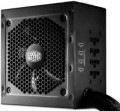Power
The output power of the power supply, in other words, is the maximum power that it is capable of delivering to the system. For the computer to operate efficiently, the power supply must be greater than the total power consumption of the system at maximum load. The latter can be calculated by summing the power of individual components, however, in general, for office configurations
, about 400 W —
450 W is considered sufficient, for medium gaming — about
600 W(
500 W,
550 W,
650 W,
700 W,
750 W), and for the top ones —
power of 800 W and above (
850 W,
1000 W and even
more than 1 kW).
Efficiency
Efficiency, in this case — the ratio of the power of the power supply (see "Power") to its power consumption. The higher the efficiency, the more efficient the power supply, the less energy it consumes from the network at the same output power, and the cheaper it is to operate. Efficiency may differ depending on the load; the characteristics can indicate both the minimum efficiency and its value at an average load (50%).
It should be noted that compliance with one or another level of 80PLUS efficiency directly depends on this indicator (for more details, see "Certificate").
ATX12V version
A standard for power supplies that supplements the ATX specifications regarding power supply along the 12 V line. Introduced into use since the time of the Intel Pentium 4 processor. In the first series of the standard, the +5 V line was mainly used; from version 2.0, the +12 V line was introduced to fully power the components computer. Also in the second generation, a 24-pin power connector appeared, used in most modern motherboards.
MOLEX
The number of Molex (IDE) connectors provided in the design of the power supply.
Initially, such a connector was intended to power peripherals for the IDE interface, primarily hard drives. And although the IDE itself is completely obsolete today and is not used in new components, however, the Molex power connector continues to be installed in power supplies, and almost without fail. Almost any modern PSU has at least
1 – 2 of these connectors, and in high-end models this number can be
7 or more. This situation is due to the fact that Molex IDE is a fairly universal standard, and with the help of the simplest adapters, components with a different power interface can be powered from it. For example, there are Molex - SATA adapters for drives, Molex - 6 pin for video cards, etc.
PCI-E 6pin
The number of 6-pin (6pin) PCI-E power connectors provided in the power supply.
Such connectors are used for additional power supply of those types of internal peripherals for which 75 W is no longer enough, supplied directly through the PCI-E socket on the motherboard (video cards are a typical example). The 6-pin connector on the power supply additionally provides another 75 W — thus, when using this connector, it becomes possible to connect boards with a power consumption of up to 150 W.
Note that some video cards have several connectors for additional power at once. Thus, the PSU can provide both
one PCI-E 6pin plug, and
two such connectors. However, in general, this type of plug is used quite rarely — this is due to the spread of a more convenient and versatile 8pin connector in the “6 + 2” format, which can be used both as six- and eight-pin (see below for more details).
PCI-E 8pin (6+2)
The number of PCI-E 8pin (6+2) power connectors provided in the PSU design.
Additional PCI-E power connectors (all formats) are used to additionally power those types of internal peripherals for which 75 W is no longer enough, supplied directly through the PCI-E socket on the motherboard (video cards are a typical example). In PC components, there are two types of such connectors — 6pin, providing up to 75 W of additional power, and 8pin, giving up to 150 W. And the 8pin (6 + 2) plugs used in power supplies are universal: they can work with both 6-pin and 8-pin connectors on the expansion board. Therefore, this type of plug is the most popular in modern PSUs.
As for the quantity, on the market you can find models
for 1 PCI-E 8pin (6 + 2) connector,
for 2 such connectors,
for 4 connectors, and in some cases —
for 6 or more. Several of these plugs can be useful, for example, when connecting several video cards — or for a powerful high-performance video adapter equipped with several PCI-E additional power connectors.

